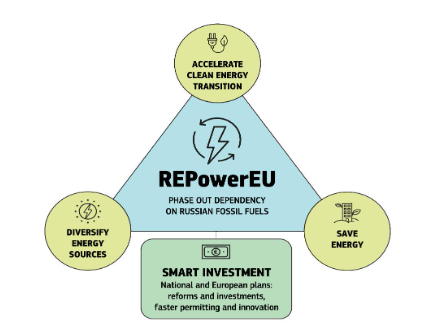
Energy Transition: One year on from Fit for 55, REPowerEU signals further significant reform
We did not expect, when the European Commission began the roll out of its highly significant Fit for 55 package to speed up decarbonisation that, 10 months later, rising commodity prices and then war in Europe would prompt the further ratcheting up of efforts to accelerate the energy transition.
What is REPowerEU?
REPowerEU is a package of legislative proposals, policy papers, and best practice & guidance documents published by the European Commission in response to the impact on Europe of the war in Ukraine.
The measures are designed to: (i) diversify energy sources away from Russian fossil fuels, (ii) accelerate clean energy transition by speeding up delivery of renewable energy in the EU; and (iii) make faster progress on reducing energy demand (energy efficiency). This is shown in the REPowerEU Communication of May 2022 as follows:

Publication of REPowerEU in May 2022 followed from: (i) the Commission’s toolbox on energy prices in October 2021; (ii) a first REPowerEU Communication of March 2022; (iii) the Versailles Declaration of March 2022; (iv) a Communication on Security of Supply and Energy Prices in March 2022; and (v) endorsement by the Council of March 2022 for the full development of a plan.
In parallel, the Commission published a Communication on Short-Term Energy Market Interventions and Long Term Improvements to the Electricity Market Design in May 2022, taking into account ACER’s broadly positive Final Assessment of the EU Wholesale Electricity Market Design.
Where does REPowerEU sit in the recent development of EU energy law?
Recap: Fit for 55 proposed legislation designed to evolve the functioning of key sectors to reduce greenhouse gas emissions by 55% in 2030 compared to 1990, deemed critical to Paris commitments and 2050 carbon neutrality.
REPowerEU requires swift implementation of Fit for 55 but notes that gas consumption will now have to decrease more swiftly, limiting its role as a transitional fuel. To support this it proposes legislative amendments, in addition to those proposed in Fit for 55, to the Renewable Energy Directive (“RED”), Energy Efficiency Directive (“EED”), and the Energy Performance of Buildings Directive (“EPBD”).
Timing: The Council and Parliament are adopting their positions on the Fit for 55 proposals with a view to negotiating them as the second half of 2022 progresses. REPowerEU amendments may well be wrapped into these negotiations, so some anticipate that legislation could be enacted fairly soon.
Targets: REPowerEU goes further than Fit for 55 on these targets:
| Current law under the Clean Energy Package | Fit for 55 proposals | REPowerEU proposals | |
|---|---|---|---|
| 2030 Renewable Electricity Target
(% of gross final energy consumption being met by energy from renewable sources) |
At least 32%. | At least 40%. | At least 45%. |
| 2030 Energy Efficiency Target
(Reduction in energy consumption) |
At least 32.5% reduction in both primary and final energy consumption relative to 2007 consumption projections for 2030 (the “2007 Reference Scenario”). | At least 39% and 36% reduction for primary and final energy consumption respectively relative to the 2007 Reference Scenario, equivalent to at least 9% reduction in energy consumption compared to the new 2020 Reference Scenario.
|
At least 41.5% and 39%reduction for primary and final energy consumption respectively relative the 2007 Reference Scenario, equivalent to at least 13% reduction in energy consumption compared to the 2020 Reference Scenario. |
What would REPowerEU do to speed up delivery of renewable energy?
Proposed amendments to the RED would add to existing provisions on administrative procedures and permit-granting. In the recent words of Commissioner Simson, “Right now we are looking at almost a decade for some offshore wind projects to get off the ground. Far too long. And time we don’t have to waste.”
What is the permit-granting process?
RePowerEU slightly widens the current meaning in Article 16 to include co-located storage. The permit-granting process would cover “all relevant administrative permits to build, repower and operate plants for the production of energy from renewable sources, co-located energy storage facilities, as well as assets necessary for their connection to the grid, including grid connection permits and environmental assessments where these are required”.
The permit-granting process would begin with acknowledgment of the validity of the application, which would have to be done according to deadlines described below, and comprise all procedures through to the notification of the final decision on the outcome.
What are renewables go-to areas?
This is one of the key innovations of the new proposals. Renewables go-to areas would be specific locations on land or sea designated by a Member State as particularly suitable for the installation of plants for production of energy from renewable sources, other than biomass combustion plants.
How would renewables go-to areas be designated?
Within one year of the legislation coming into force, Member States would identify the land and sea areas necessary for the installation of the renewable energy needed to meet national contributions under the Effort Sharing Regulation (as notified to the Commission in National Energy and Climate Plans).
Within two years of the legislation coming into force, Member States would adopt a plan or plans designating renewables go-to areas for one or more types of renewable energy sources. The plan(s) would:
- designate sufficiently homogeneous land and sea areas where the deployment of a specific type or types of renewable energy is not expected to have significant environmental impacts, and
- establish rules for the go-to areas. The rules would include mitigation measures to be adopted for installation of renewable energy plant, co-located storage facilities, and assets necessary for connection to the grid, in order to avoid or significantly reduce negative environmental impacts in line with provisions of the Habitats Directive, Birds Directive, and Water Framework Directive.
Given Ireland’s very ambitious climate and decarbonisation targets for this decade, there is a strong case for designating the fullest extent of land and sea area possible as go-to areas.
What do the proposals say about time periods for the permit-granting process?
REPowerEU seeks to speed up the permit-granting process particularly for designated go-to areas:
| Current law under the Clean Energy Package
|
REPowerEU proposals for renewables go to areas
|
REPowerEU proposals for areas outside go to areas
|
|
|---|---|---|---|
| Time for validating applications.
|
Within 14 days of receipt of an application.
|
Within one month of receipt of an application. | |
| Time in which the permit-granting process must be carried out.
|
Two years for power plants, extendable by one year in extraordinary circumstances
. |
One year, extendable by three months in extraordinary circumstances. | Two years, extendable by three months in extraordinary circumstances. |
| Time in which the permit-granting process must be carried out for repowering, small new installations and (under REPowerEU) co-located storage facilities as well as their grid connection. | One year, extendable by a further year in extraordinary circumstances, for repowering and installations with electrical capacity of >150 kW. Member States may also set up a shorter process for repowering.
|
Six months, extendable by three months in extraordinary circumstances, for repowering, new installations with electrical capacity of >150 kW, co-located storage facilities as well as their grid connection.
|
One year (to include environmental assessments where required), extendable by three months in extraordinary circumstances, for repowering, new installations with electrical capacity of >150 kW, co-located storage facilities as well as their grid connection.
|
For projects in go-to areas, lack of reply by administrative bodies within prescribed deadlines would lead to a presumption that an administrative step is approved (except in cases where a project is required to carry out an EIA, as outlined below).
Deadlines would apply without prejudice to court / tribunal proceedings and alternative dispute resolution mechanisms, and so could be extended for the duration of such procedures. However, Member States would have to ensure that projects for development of renewable energy or related grid connections would be subject to the most expeditious administrative and judicial procedure available.
Do the proposals mean that projects do not have to carry out environmental assessment?
Go-to areas: Because go-to area plans would be subject to an environmental assessment, applications for renewable energy plants (including repowering) would not have to carry out an Environmental Impact Assessment (“EIA”), provided they comply with the rules in the go-to area plan. They would also be exempted from carrying out an Appropriate Assessment (“AA”).
There would however be a screening process first. If screening indicates that a project is highly likely to give rise to significant unforeseen adverse effects in view of the environmental sensitivity of the geographical area, which were not identified during the environmental assessment of the go-to area plan, normal requirements around EIAs and AAs would apply.
Screening would have to be done in 30 days (and, for repowering of plants, 15 days). Screening for repowering would be limited to the potential impacts stemming from the change / extension compared to the original project.
It remains to be seen how this might work in practice, particularly in relation to the level of information authorities (presumably An Bord Pleanála) might require at screening stage.
Areas outside go-to areas: Environmental assessments would be carried out in a single procedure combining all relevant assessments for a given project. The competent authority, taking into account the information provided by the developer, would issue an opinion on the scope and level of detail of information to be included in the EIA. Where projects adopt appropriate mitigation measures, killing or disturbance of the certain species protected under the Habitats Directive and Birds Directive would not be considered deliberate. Pilot projects could provide for novel mitigation measure provided there is close monitoring and adaptive management.
What about single contact points?
Ireland is currently required under the RED to set up or designate contact points to guide applicants through and facilitate the entire administrative permit application and granting process. Applicants should not be required to contact more than one contact point for the entire permit-granting process.
Transposition of these provisions to domestic law was required by mid-2021, and the Climate Action Plan 2021 sets Q2 2022 as the date by which a contact point will be designated.
REPowerEU would also require that contact points ensure that the deadlines for the permit-granting procedures are met. All procedures would be carried out in electronic format within two years of the amendments entering into force.
It is considered that establishing contact points, sometimes referred to as one-stop shops, is a really ambitious task. In Ireland, authorities responsible for permitting include An Bord Pleanála (as well as other planning & land management bodies), the Commission for Regulation of Utilities, and EirGrid, each acting on the basis of different legislation. Stakeholders across the industry will be well aware of resourcing issues impacting permitting in Ireland, particularly in relation to planning and grid connection, as well as the short to medium term actions being suggested to alleviate bottlenecks and their impact on RESS timelines.
What does REPowerEU say about overriding public interest?
Another innovation is that until climate neutrality is achieved, Member States would be required to ensure that in the permit-granting process, the planning, construction and operation of renewable energy plants, their connection to the grid and the related grid itself, and storage assets are presumed to be the overriding public interest and serving public health and safety when balancing legal interests for the purposes of the Birds, Habitats, and Water Framework Directives.
This has the potential to significantly strengthen prospects for project success, particularly in cases in which the decision to grant planning permission would, under current law, be finely balanced.
What about solar power?
The Commission considers that solar photovoltaics is one of the fastest technologies to roll out. There is a new target to install over 320 GW of new solar PV by 2025, over twice today’s level, and nearly double that again by 2030.
There would be a permit-granting timeline of three months for installation of solar energy equipment, including building-integrated solar installations, in existing or future artificial structures, provided that the primary aim of such structures is not solar energy production. An EU Solar Strategy is also published, as well as an amendment to the Energy Performance of Buildings Directive, described below.
What else does the Commission say about what it expects from Member States?
The Commission published a Recommendation and Guidance on speeding up permit-granting procedures for renewable energy projects and facilitating Power Purchase Agreements. The Recommendation instructs Member States to take actions in several areas and the guidance identifies examples of best practice. Though not binding, these provide examples of the steps the EU considers it reasonable for Member States and stakeholders to pursue in fulfilling their obligations under EU law.
There is also a Technical Support Instrument for Member States and an Energy and Industry Geography Lab to assist in the identification of go-to areas.
What does REPowerEU say about hydrogen & biomethane?
A Staff Working Document on investment needs, hydrogen accelerator and achieving the bio-methane plan targets outlines plans to accelerate production of green hydrogen and double production of biomethane by 2030. Consultation also began on Commission Delegated Regulations that elaborate the regulatory framework for renewable hydrogen.
How does REPowerEU propose to speed up progress on energy efficiency?
Buildings to be fit for solar: In addition to the revised target in the Energy Efficiency Directive, an amendment to the Energy Performance of Buildings Directive would require Member States to ensure that all new buildings are designed to optimise their solar energy generation potential on the basis of the solar irradiance of the site, enabling later cost-effective installation of solar technologies. Member States would be required to ensure deployment of suitable solar energy installations on all new public and commercial buildings (with useful floor area >250 sq.m.) by the end of 2026; on all existing such buildings by the end of 2027; and on all new residential buildings by the end of 2029.
Short and long-term measures: EU Save Energy Communication presents a two-pronged approach: strengthening structural change with mid- to long-term energy efficiency measures and achieving immediate energy savings through behavioural changes.
Security of supply and market interventions
Common purchasing: The Commission and Member States set up an EU Energy Platform for voluntary common purchase of gas, LNG and hydrogen, intended to support demand aggregation and structuring; optimised and transparent use of import, storage and transmission infrastructure; and international outreach. A voluntary operational ‘joint purchasing mechanism’ will also be considered for the purpose of negotiating and contracting aggregated gas demand on behalf of Member States, which would competitively release supplies to the market. It remains to be seen how Ireland would participate given its market and infrastructure connection to the UK.
Storage: The proposal for a Regulation on measures to safeguard the security of gas been agreed by the EU institutions. It sets gas storage filling requirements of 80% for this year and 90% for subsequent years (although there is a derogation for Ireland). Gas storage facilities will require certification which can be refused if a person who directly or indirectly controls or exercises any right over the storage system operator may put at risk the security of energy supply.
Market interventions: The Commission also published a Communication on acceptable short-term emergency measures and long-term improvements in the gas and electricity sectors. Short-term measures suggested for consideration include financial support for customers diverted from congestion revenues or from infra-marginal rent. Any proposal to tax inframarginal rent is complex: conventional generators may be paying high prices for fuel or, conversely, may have adequately hedged against high fuel prices, while inframarginal benefits accruing to renewable generators will depend on a private commercial arrangement, namely the PPA with their supplier. Suggested long-term improvements will require further development and consideration in the context of both the ACER Final Assessment and the significant market reform already underway pursuant to the Clean Energy Package.
Next Steps
The innovations and timelines envisaged for project development will be widely welcomed. Much remains to be seen in how they will be implemented, and implementation will be challenging. However, there is wide acknowledgment that permit-granting procedures need to improve.
The ability to designate renewables go-to areas in Ireland will likely require completion of current work streams such as the revision of the Wind Energy Development Guidelines. The REPowerEU approach to mitigation measures, monitoring & adaptive management, and overriding public interest may help to bring higher numbers of projects through the planning process but risk of legal challenge remains. In Ireland, issues around grid investment, as well as uncertainty around market rules as work continues to implement the Internal Market in Energy Regulation, will need to be addressed if we are to seize the full advantage of the type of efficient, streamlined approach the EU intends to mandate.
The Commission has indicated that it will monitor progress not only through National Energy and Climate Plans, but also through reporting under the new Recovery and Resilience Facility, set up during the COVID-19 pandemic to support sustainable recovery. Guidance will be published in the second half of 2022 for Member States to update National Energy and Climate Plans, due in 2024. As we are now beginning to see the Commission take steps to enforce transposition of the Clean Energy Package, it is safe to predict that legal enforcement mechanics will also be pursued in due course if necessary.



